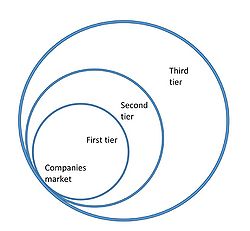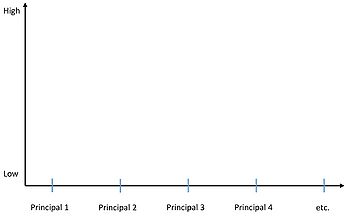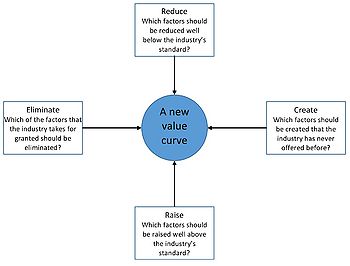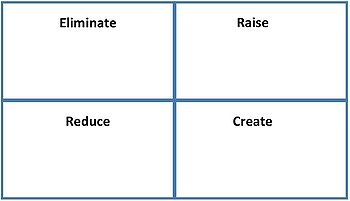Blue ocean strategy for project management
Blue Ocean Strategy
A blue ocean strategy is a tool used to gain competitive advantage, it is a strategy on how to create a uncontested market space and make the competition irrelevant. Every new product or service on the market is there to stay, not all will be able to handle the bloody competition and with time the underdogs will fade out of the market. Differentiating from the market, will allow companies to "escape" the competitiors, and be in a ocean of their own.
The blue ocean strategy was developed by W.Chan Kim & Renée Mauborgne. They met in class where Mr. W.Chan was a professor, and Miss Reneé was a student, twenty years ago (1995)
The strategy is relevant for everyone , companies, corporations, entrepreneurs, etc. that want to differentiate from the current competition. When managing a project, there are many aspects that need to be considered. Projects are usually formed to be sustainable and profitable, to gain an advantage on the current market the blue ocean strategy is a strong tool to work towards sustainability and profitability. [1] [2] [3]
Contents |
Blue ocean vs. Red ocean
Red ocean is the definition on the current existing markets. In those markets the competition is bloody, companies are fighting for a share of the available customers for a potential profit. Most companies cannot stay in this heated competition for a long time without going bankrupt. The big players in each market within the red ocean dominate the smaller players, therefore the need to think outside of the box is necessary to develop a sustainable career. The blue oceans are so called unidentified markets, in blue oceans are no current competitors because the ocean is clear for whoever comes there first. Blue oceans are developed from red oceans with three tools to create them. These three tools are strategy canvas, identifying focus points and the eliminate-reduce-raise-change grid. Blue oceans eventually turn red, imitators will always exist and competition will arise with hungry competitors wanting their share of the cake. [4] [5]
The 8 Principles of Blue Ocean Strategy
There are 8 principles that guide the way into how to develop a strategy into a blue ocean and how to execute them. The 8 principles are categorized into two different steps, the formulation principles and the execution principles.
Formulation Principles
The first step is to formulate the path into the blue ocean. Following are the four principles on what to consider to formulate a blue ocean strategy.
Reconstruct Market Boundaries
The first principle of the blue ocean strategy is to reconstruct the market boundaries. It includes risks that some companies are not willing to take, and therefore end up being a riverboat gambler. Subsequently the six path framework was developed for companies to use to create a blue ocean, no matter the industry. [1]
The first path of six in the six path framework is: Look across alternative industries
Competitors do not only exist in the same industry, there are also companies that produce alternative products or services that are in other industries. Those products or services may have different forms or functions but offer the same functionality, and have the same purpose. Looking across alternative industries, there might be a gap to develop a blue ocean.
e.g. Cinemas versus restaurants. They are different, cinemas offer a visual entertainment, while restaurant offers more of a social gathering entertainment. Even though these two are different, they have the same purpose, and that is for people to enjoy. [1]
Second path is: Look across strategic groups within industries
There are companies within the same field of industry that pursue similar strategies, therefore are classified into strategic groups. These groups can be ranked in an hierarchical order built on price and performance. Where most companies focus on outperforming other firms within these strategy groups. [1]
e.g. Global gyms versus Crossfit gyms. At a global gym, members show up to exercise most often out of necessity. On the other hand, at crossfit gyms members show up to socialize and exercise. Both options compete in the same market with different focus points.
Third path is: Look across the chain of buyers
There are three groups of buyers. The purchasers, the users, and the influencers. These three groups may overlap, but the purchasers may differ from the actual users and sometimes influencers are important as well. Companies can target different buyer segment to discover a new blue ocean.
e.g. Novo Nordisk the Danish insulin producers created a blue ocean within the field of pharmaceutical industry. In most cases pharmaceutical companies focus on the influencers (doctors), but Novo Nordisk changed their focus buyer to users. In the past, insulin had to be injected via needles, which only doctors could prescribe to the patients. With development and new innovations, Novo Nordisk invented the NovoPen which was user-friendly and eliminated the hassle of needles. [1]
Fourth path is: Look across complementary product and service offerings
Companies need to think about what happens before, during and after the product or service is used. Sometimes extra service is needed for the customers to be interested to use the service or buy/invest in the products.
e.g Movie theaters. Parking may be a problem in some cases, and if the customer doesn't feel like looking for a place to park they will eventually not go to the cinemas. Therefore, cinemas need to provide customers with easy and good parking areas. [1]
Fifth path is: Look across functional or emotional appeal to buyers
Some companies compete for price and functions, while other companies compete for customers feelings.
e.g. Fast food chains vs. fancy restaurants. Both compete in the same field of industry, but with different focus points. Fast food chains, focus on fast delivery, low prices, functional menus and high turnover of customers. While, fancy restaurants focus on experience, quality food, relaxing environment and customer satisfaction. [1]
Sixth and the last path is: Look across time
With time come changes, and industries need to adapt to those changes.
e.g. with the green house gas emission(GHG) effects, industries that rely heavily on gas need to adapt to the fact that GHG needs to be reduced. Airplane, car, and boat producers are all working on engines that pollute less. Even some companies now have electrical vehicles, like Tesla, that release no GHG into the air. [1]
Focus On the Big Picture, not the numbers
Many companies tend to get stuck in red oceans. The reason is that on a short term basis the numbers that a particular company makes, is the main focus of the business. As well as, the risks that are involved in changing strategies. There are four major steps when drawing the strategy canvas (analytical tool, section 4.1), which are built on the six paths. The four steps are visual awakening, visual exploration, visual strategy fair and visual communication.[1]
Visual awakening involves drawing of the first strategy canvas, that allows companies to see where the current focus is at, as well as competitors focus. This step is major to see how similar the current strategy in todays market.
Visual exploration depends on a lot of research, why customers buy and why non-customers don’t buy. This is a critical step in understanding what the current customer values, and what the non-customers wants. Several strategy canvases are drawn with different focus points, to have the divergence for the next step.
Visual strategy fair involves presenting all of the pervious drawn strategy canvases for a certain group of people that each company finds accurate to present it to. Then each member is then asked to vote for their favorite strategy canvas and asked to explain why they came to that conclusion. This feedback gives a solid foundation on where to place the focus at to develop the final strategy canvas.
Visual communicate: Once the final and future strategy has been developed, the strategy is then presented to every employee at the firm. Employees are informed where the future value should be at, and what should be eliminated; reduced; raised; and created. This is extremely necessary for every employee to know, so everyone can work towards the same goal.
Reach Beyond Existing Demands

To reach beyond the existing demands, companies need to look past the current customers and reach to the noncustomers which can be turned into future customers. There are three tiers of noncustomers, first tier (soon-to-be) it is the noncustomers that are closest to the market. Those noncustomers only buy your service or product out of necessity, if there were a substitute product they would eventually become a competitor’s customer. If values would be added to the current service or product those noncustomers would jump onboard. [1]
The second tier (refusing) of noncustomers are noncustomers that have decided that the service or product doesn’t fulfill their needs, or they refuse to use these offerings. Therefore, they don’t see the necessity in the offers, and turn to something else.
The third tier (unexplored) of noncustomers, are those that the market has never tried to target. The market that doesn’t even know about the companies’ products or services.
These three non customers groups, see figure 1, should always be considered as a possible future customers. Each tier needs to be heavily researched and calculated to see which of them would expand the customer market the most. Also, the tiers can have overlapping commonalities which has to be taken into account. The idea with reaching beyond the existing demand is to catch the largest non-market share and expand the blue ocean.
Get the Strategy Sequence Right
Once the previous principles have been formed, it is time to get the strategy sequence right. Getting the sequence right is a formal step in leaping into a blue ocean, it ensures that strategy will appeal to the market. There are four steps in the sequence; buyer utility, price, cost and adoption.
First it is buyer utility, does the product or service offer the potential customer some benefits. If it doesn’t it's clear that there is no blue ocean for this particular offer, and the idea needs to be rethought.
Second is the price; the price should be fair for both partners. It should be attractive enough for the customer to buy it, and also obviously be profitable for the company.
Third is cost, the cost is a key element in bringing the offer to a customer at a fair price. It is obvious that the cost needs to be lower than the price to be profitable. The cost should not come down on the utility of the product or service. If the cost cannot be lowered the strategy needs to be further developed so the customer will be attracted to the right prices.
The fourth and last is adoption. Adaption consist of knowing all of the hurdles, and they should be known in advance. Swimming from red ocean to blue ocean, is certainly not easy and even though the people behind the new idea have faith in the product or service others might think differently. That means, it will be hard to adopt the offer for the vendors to bring it to the market. [1]
Execution Principles
Once the formulation for the blue ocean strategy has been formed, the formulation should then be executed accordingly. The following subchapters contain the four principles, and describe what to consider for execution.
Overcome Key Organizational Hurdles
There are four key organizational hurdles that managers face when developing a strategy for a blue ocean. The four hurdles are:
Cognitive: informing employees that there is a need for change in strategy for future growth and sustainability.
Resources: the greater the change in strategy, the need for resources become higher to be able to execute.
Motivation: it is necessary to motivate key stakeholders and key players to change the strategy towards a better future.
Politics: politics will always exist, and there is always someone willing to turn against new ideas. [1]
Build Execution into Strategy
Changing strategies requires significant change within each corporation. These changes cannot be made only with the top players within each firm. The need for everyone, from the top down to the bottom employees, to participate in these changes is key to success. Therefore, the need for trust from all employees is necessary for the strategy to be successfully applied and sustainable. [1]
Align the Value, Profit and People Proposition
There are three types of proposition that each firm has to align to successfully adapt a sustainable strategy, those are: value proposition, profit proposition and people proposition.
Value proposition: it must be clearly visual within each firm for them to attract potential customers to buy.
Profit proposition: each company has to make money of off what they offer.
People proposition: all employees must be motivated to work towards changes of strategy for future growth.
When developing a blue ocean strategy, these three proposition need to be aligned with the sight on pursuing both differentiation from the market as well as low cost products or services. If either differentiation or low cost is pursued a red ocean strategy is being formed. On the other hand, if these three proposition do not align, the strategy change will most often develop into complete failure.[1] [4] [6] [7]
Renew Blue Oceans
Once a blue ocean has been spotted and created, it will eventually turn into a red ocean. The reason for that is, when a company creates a strategy to form a new market space, there will always be someone who will imitate. Imitators are competitors and therefore does competition arise within that ocean and it turns red. With time competition just gets tougher, harder and more bloody. In that case looking across time and into the future is highly important, renewal is needed to re-gain that competitive advantage and always to stay ahead of them. Renewal of blue oceans are however not always necessary, e.g. if the competition can be dominated, and the profit stream is still huge. Swimming as far as possible into the ocean should be the goal before deciding to renew it. [1]
Analytical Tools & Frameworks
The analytical tools and frameworks are used to identify and diagnose where in the ocean each company is located. When the location has been found, the process of turning the focus from red oceans to blue oceans begin. The focus points are shifted with the tools and frameworks to create new markets, and new demand.
Three Steps
Strategy Canvas

The strategy canvas is the first tool, it is used to diagnose where in the current market competitors are focused on when producing and delivering their product or service to the customers. To understand each market, the principal factors in the specific markets are identified. The strategy canvas consist of two axes, x and y (figure 2). The previously identified principals in each market are placed along the x-axis, no matter the order. The y-axsis goes from low to high, so the relevant principle can be rated accordingly to the current standard of the market. Once every principal has been rated, it is easy to see where the lack of focus is and where the main focus lies. [1] [8] [9]
Four Action Framework

The four action framework (Figure 3) is the second tool, and is used to reconstruct the buyers value to create new values.
There are four key questions used, to create new value curve for new markets. Those are:
1. Which of the factors that the industry takes for granted should be eliminated?
This forces the companies to ask themselves "what factors could or can be eliminated" that the current market has been competing on for a long time and eventually takes for granted. This can be factors that the customers do not value anymore and can even detract the value of the product or service provided.
2. Which factors should be reduced well below the industry's standard?
This forces the companies to clearly identify if the current products or services have been to well designed to match or beat the competitor, therefore the companies are loosing money on something that is unnecessary to their business, and can be reduced to reduce unnecessary costs.
3. Which factors should be raised well above the industry's standard?
This pushes the companies to raise their standard of something that the industry has forced on to the customers to accept.
4. Which factors should be created that the industry has never offered?
This question is the key to blue oceans, and is for the companies to discover new values for the customers. Values that will create new demand in new markets. [1] [9]
Eliminate-Reduce-Raise-Create Grid

The third and final tool is the eliminate-reduce-raise-create grid, and is used as a supplementary to the four action framework. This tool allows the companies to act on the four previously asked question in the four actions framework tool. This grid gives companies four instant benefits:
- It pushes them to simultaneously pursue differentiation and low costs to break the value-cost trade-off.
- It immediately flags companies that are focused only on raising and creating and thereby lifting their cost structure and often over engineering products and services.
- It is easily understood by managers at any level, creating a high level of engagement in its application.
- Completing the grid drives companies to robustly scrutinize every factor the industry competes on, making them discover the range of implicit assumptions they make unconsciously in competing.
The grid consist of 4 blocks, where each block refers to one of the four actions (figure 4). In each block the focus points are marked, so it is visual to everyone where the focus lies. [1] [9]
Three Characteristics
There are three characteristics for a great strategy that is formulated and executed with the 8 principles and the tools and framework. They are focus, divergence and a compelling tagline. [1]
Focus
While developing the strategy canvas, companies have made clear in advance where they want to differ from the current markets. Those points are where they place their focus on. Most red ocean companies tend to focus on to many points, which turns into average products or services. While, blue ocean companies have fewer focus points and deliver higher quality for those focus areas. [1] [10]
Divergence
When two or more companies are competing in the same market, they focus on the same values. In that case does divergence not exist. Therefore, creating a product or service in the same field but with different focus factors, then divergence has been created. When the divergence is present, new markets are being formed. [1] [10]
Compelling Tagline
A compelling tagline is the final of the three characteristics. The tagline needs to include a clear message and advertise where companies has their focus on, it is the audible representation of each brand.
e.g - Nike "Just do it". It clearly states what Nike encourages you to just begin, no matter the shape you are in or in what state of mind you are. [1] [10] [11]
References
- ↑ 1.00 1.01 1.02 1.03 1.04 1.05 1.06 1.07 1.08 1.09 1.10 1.11 1.12 1.13 1.14 1.15 1.16 1.17 1.18 1.19 1.20 1.21 1.22 1.23 1.24 1.25 W. Chan Kim & Renée Mauborgne (2015) The Blue Ocean Strategy. USA. Harvard Business School Publishing Corporation
- ↑ "Blue Ocean Strategy"
- ↑ "Blue Ocean Strategy: Creating Your Own Market"
- ↑ 4.0 4.1 "Red Ocean vs. Blue Ocean"
- ↑ "Blue Ocean"
- ↑ "3 Proposition"
- ↑ "Alignment"
- ↑ "Strategy Canvas"
- ↑ 9.0 9.1 9.2 "5 Prove steps to creating your own blue ocean strategy"
- ↑ 10.0 10.1 10.2 "Marketing tips of the week"
- ↑ "Slogans & Brand tagline"